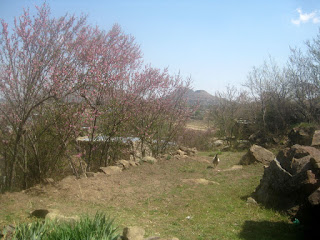During our time in Lesotho, I have developed an interest in traditional Basotho cooking. I even managed to make an arrangement with our housekeeper to trade cooking lessons. I had heard that she was interested in American cooking, so I offered her a deal: I would show her some American cooking if she would show me some Basotho cooking. It worked out great. She was mainly interested in baking, so together she and I have made cookies, muffins, cobbler and a pie. And we have also made papa, moroho and chakalaka (pah-PAH, moh-ROH-ho and chah-KUH-lah-kuh). Papa is a maize meal based dish that looks like mashed potatoes but is much more solid.. Moroho literally means vegetables but in this context means cooked greens. Chakalaka is a spicy dish that has many variations, but in general is vegetables and beans in a tomato sauce spiced with Atchar.
As I learned to prepare traditional Basotho food, I needed people to try it for me. So I began to share it with our guards, all of whom are Basotho. They enjoyed it, as apparently I have learned to prepare those dishes correctly. They also began to talk with me about traditional Basotho food and cooking. This included mentioning many dishes our housekeeper did not know how to prepare. Fortunately, as this culinary learning experience was unfolding, a new book was published here in Lesotho: Cuisine of the Mountain Kingdom. Perfect timing. It included many more traditional recipes, which I have since tried and enjoyed, and which the guards have enjoyed, too. My favorites so far is sekele (seh-KAY-lay), a sweet pumpkin dish.
Conversations about traditional cooking also included mention of preparation method. Basotho cooking is properly done outdoors, over a fire, in a large metal pot. So one of our guards, Johannes Marabe, addressed as Ntate Marabe (n-DAH-tay muh-RAH-bay) and who has become a good friend, offered to take me to his place where he stays in Maseru to show me more traditional cooking. His place is actually just one room, without electricity or indoor running water. It is up on a hillside, though, with a line of peach trees in front.
Here he is in front of his place.
And me, too.
We needed to chop some wood for the fire, and since he has no axe, he used the edge of his spade.
Then he got the fire going in an outdoor corner where the wind would be at a minimum.
This is one of the pots used in traditional Basotho cooking.
Here I am chopping the greens (mostly spinach) for the moroho.
And stirring the papa.
Ntate Marabe's landlady, 'M'e Mathapelo (may mah-TAH-peh-loh), oversaw the operation.
We dined well once the papa and moroho were done. I was surprised by how satisfying the meal was, despite its simplicity. Maize meal and cooked greens. That's it. But preparing them entirely outdoors, including cooking them over an open fire, made them taste better somehow.
We had traveled out to Ntate Marabe's place by taxi (which here is typically a minivan), and he escorted me back through his village to the taxi.
Along the way, we had to cross a couple of dongas (ravines or ditches caused by soil erosion). When it rains heavily, these can be impossible to cross without getting wet.
We bid farewell, and I boarded the taxi, finding a seat in the back.
We passed row houses.
And roadside merchants.
Riding along, I shot this video looking out at neighborhoods, which I imagine are typical of what much of living in Maseru is like for the Basotho. Quite a contrast to the house where I live.
I have to say, spending the day with Ntate Marabe, getting an opportunity to cook with fire, or ho pheha ka mollo (ho pay_HAH kah moh-LOH), and to see where and how he lives, was one of the best and most eye-opening experiences of my time here. In case you are wondering, ho bapala (hoh bah_PAH-lah) means "to play", hence the title of this entry translates as "to play with fire".)
- - - - -
It is closed now, as a newer hospital recently opened on the outskirts of town. Here, you can see some of the old equipment just piled up on the porch.
As I understand it, there is now talk of re-opening the Queen II as it is more accessible and easier to staff. The new hospital is very modern and was constructed and equipped with a great deal of external funding, but they are having difficulty keeping it staffed with people who know how to use the equipment, and - unlike the Queen II - it is nowhere near the main taxi stop in town. Sigh.





















No comments:
Post a Comment